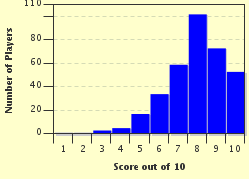Quiz Answer Key and Fun Facts
1. Which of the following words describes the practise of eating insects?
2. In the first decade of the 3rd millennium, the eating of insects was rare in the developed world.
3. Insects are exothermic (ectothermic). Biologically speaking, which of the following best describes the term exothermic?
4. Which of the following is a real advantage of farming insects as a food source rather than beef?
5. There are no risks in eating bugs.
6. When considering nutritional value, which of the following is generally true about insects?
7. Does the Bible totally condemn the consumption of insects?
8. The aboriginal people of which country consider the witchety grub a nutritional delicacy?
9. What is the term given to describe the intentional cultivation of insects for human consumption?
10. Do all bugs taste like chicken?
Source: Author
pollucci19
This quiz was reviewed by FunTrivia editor
WesleyCrusher before going online.
Any errors found in FunTrivia content are routinely corrected through our feedback system.


